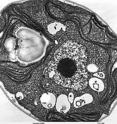How cells know when it's time to eat themselves
Researchers at the University of California, San Diego School of Medicine have identified a molecular mechanism regulating autophagy, a fundamental stress response used by cells to help ensure their survival in adverse conditions. The findings are published online in the January 17 issue of Cell.
Senior author Kun-Liang Guan, PhD, a professor of pharmacology at UC San Diego Moores Cancer Center, and colleagues report that an enzyme called AMPK, typically involved in sensing and modulating energy use in cells, also regulates autophagic enzymes.
Autophagy, which derives from the Greek words for "self" and "eat," is triggered to protect cells when times are tough, such as when cells are starved for nutrients, infected or suffering from damaged organelles, such as ribosomes and mitochondria. Much like the human body in freezing conditions will reduce operations in extremities to preserve core temperatures and organ functions, cellular autophagy involves the degradation and synthesis of some internal cellular elements to ensure survival of the whole.
The scientists found that AMPK regulates different complexes of an enzyme class called Vps34 kinase in different ways. Some Vps34 enzymes are involved in normal cellular vesicle trafficking -- the vital movement of molecules inside a cell. Other Vps34 complexes are involved in autophagy. Guan and colleagues say AMPK inhibits some non-autophagy enzymes, but activates autophagous ones.
The study more fully illuminates a process essential to healthy cell function and survival. "Autophagy is an important way for cells to clear damaged parts that could be harmful to them and to digest parts for nutrients when cells are experiencing starvation conditions," Guan said.
More broadly, he noted that "defects in autophagy have been associated with human disease, such as cancer and neurodegenerative disorders." Failure of normal autophagy has also been associated with accumulated cell damage and aging.
Co-authors are Joungmok Kim, Department of Oral Biochemistry and Molecular Biology, Kyung Hee University and UCSD Department of Pharmacology and UCSD Moores Cancer Center; Young Chul Kim, Chong Fang and Ryan C. Russell, UCSD Department of Pharmacology and UCSD Moores Cancer Center; Jeong Hee Kim, Department of Oral Biochemistry and Molecular Biology, Kyung Hee University; and Weiliang Fan, Rong Liu and Qing Zhong, UC Berkeley Division of Biochemistry, Biophysics and Structural Biology, Department of Molecular and Cell Biology.
Funding for this research came, in part, from grants from the National Institutes of Health ((R01CA108941; R01GM51586) and U.S. Department of Defense and the Bio&Medical Technology Development Program of the National Research Foundation of Korea.
Source: University of California, San Diego Health Sciences
Other sources
- How cells know when it's time to eat themselvesfrom Science DailyThu, 17 Jan 2013, 19:30:27 UTC
- How cells know when it's time to eat themselvesfrom PhysorgThu, 17 Jan 2013, 17:00:30 UTC
